Last week we inspected both the Saliva Hive (primary swarm), and our smaller nuc hive (afterswarm), and noted that the difference in progress between the two hives was due to the presence of a mated Queen in the primary swarm, and a virgin Queen in the afterswarm colony.
Yesterday, 17 days after we captured the afterswarm, we decided to inspect this colony again. The purpose for this inspection was purely to see if there was any evidence that the Queen in this colony is fertile. Our last inspection revealed lots of comb, with nectar, and a little pollen, but no evidence of eggs or larvae.
Our primary concern was that if the Queen proved not to be fertile we’d need to react soon, by either re-queening the hive with a purchased, mated Queen, or transferring a frame with eggs from the Salvia Hive in the hopes the bees would raise an emergency Queen of their own. Without a fertile Queen, no replacement worker bees will be produced.
As we lifted the lid and the inner cover, we noted a few bees in the upper hive body, and they are just starting to draw out two of the new frames with comb. The majority of the bees were still lurking down in the lower hive body.
We removed the upper hive body and set it aside, to see what was going on down below. Even though we were sure we’d pushed the frames tightly together after the last inspection, there was a small gap, and we found a little bit of brace comb between two frames. The wax was new and soft, and so the frames were easily separated, and the brace comb removed.
We pulled the number 2 frame first as the bees don’t tend to work the outside frames as much, and it was obvious that the bees have been storing more nectar, and more pollen over the last week. The top of the frame had a little capped honey…
with pollen and nectar stored below.
This is encouraging, as the bees will need these stores to feed brood.
If the frame had evidence of eggs or larvae we’d expect to see them below the band of pollen, but those cells only contained nectar. Disappointed, we moved on to the next frame.
Scanning the frame from top to bottom, again, capped honey, pollen, and…wait a minute…
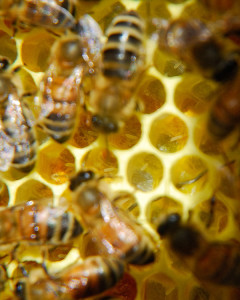
If you look closely, at the bottom of the cells, you can see tiny bee eggs that resemble miniature grains of rice (click image to enlarge)
YES! EGGS! ***Insert happy dance here***
Down in the bottom of some of the cells there were tiny little bee eggs. They resemble minature grains of rice, standing on end, in the center of each cell, and there were a lot of eggs.
We turned the frame over, and found more eggs! What a relief, pass the cigars (chocolate ones of course)!
Eggs aren’t always easy to spot, especially in new honeycomb as the wax is white. Wearing a veil makes them even more difficult to see. Fortunately the bees helped us out in some of the cells, as pollen was stored on the other side of the frame, improving contrast and visibility.
As we scanned the remaining frames we determined there were eggs laid on both sides of two of the frames. No larvae were present, so it was clear the Queen had only recently begun to lay eggs. She can lay between 1000-2000 eggs a day. If we’d checked on Friday, there’s a good chance we wouldn’t have seen anything, as most of the eggs seemed to be 1 and 2 day-old eggs. When they are first laid they stand vertically in the cell, and then slowly tip over until they lay almost flat on the floor of the cell by day 3, at which point they enter the larval stage.
The pattern of eggs on the frames looked excellent, with very few empty cells between the eggs, and a good pattern of nectar and pollen surrounding the cells with the eggs. Each cell contained only a single egg. So for now we presume it is indeed the Queen who is laying, and not a worker. Sometimes in failing hives worker bees can lay infertile eggs (which would develop only into drones), and often a laying worker will lay multiple eggs in a single cell.
So the news from the afterswarm colony is looking much more promising than last week. Until the eggs develop into larva, and are subsequently capped, we won’t know for certain that the Queen is laying fertilized eggs.

This picture from the Salvia Hive from last week shows flat capped worker brood (yellow arrow), versus dome capped drone brood (red arrow). We hope to see lots of worker brood caps at the next inspection
At the next inspection if we see evidence of worker brood, in flat capped cells, we will know the Queen is fertile. If we only see domed shaped caps, evidence of drone brood, it would suggest she is an unmated/poorly mated Queen, and may need to be replaced.
We didn’t inspect the Salvia Hive this week, but we did remove their supplemental feed. This hive is amazingly robust for being only a month since the swarm was hived. Plenty of nectar and pollen is coming into the hive, and consumption of supplemental feed was down significantly.
The entrance feeder was a little stuck in the entrance, and while trying to remove it we did inadvertently stand in the bee-line (the main bee highway from the field to the entrance) just briefly. Suddenly we were surrounded by a cloud of bees. Clearly we had interfered with air-traffic control, and inbound field worker flights were stacking up in a holding pattern. Realizing what had happened, we stepped aside. Cleared for landing, a surge of bees made a phenomenal rush for the door as you can see below. This is why you should never stand in the bee-line…so sorry girls! We then moved back to the side of the hive to wrestle the feeder out of the entrance.

We've never seen so many pollen-laden bees try to enter the hive at once! Sorry girls! (click image to see the dash for the door)
As the Saliva Hive hums along, and the eggs in the afterswarm Nuc develop, this week we’ll be setting out two new hives on the hive stand, ready for our original two packages of bees that we ordered in January to arrive. The packages are scheduled to arrive on Thursday, so this will be a very bee-sy week. In the meantime as it looks like the afterswarm hive will be building population soon, we have yet another hive to paint, so we’ll have a larger hive to house them in as this colony grows. Hopefully then we can get back in the garden. It’s really been all about the bees around here lately!



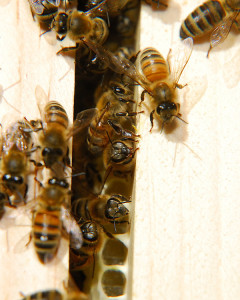
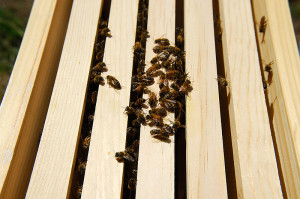



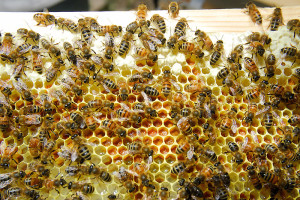
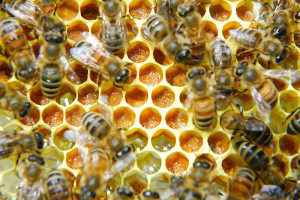
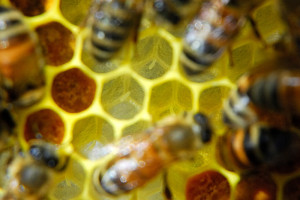
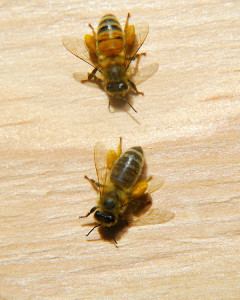
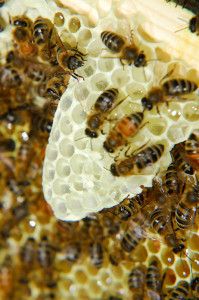







Oh that’s encouraging news. Here’s to flat capped cells in a few days.
I wonder where all the busy bees who are visiting my blossoming hawthorn tree are taking the pollen.
Have you heard anything about the new documentary Queen of the Sun?
Perhaps you have a feral colony near you? Or maybe a neighbor is covertly keeping bees?
I’ve heard good things about the documentary. One of our guild members has seen it. They did mention they thought the naked beekeeper was a little odd, but otherwise it was a great film 😉
I hope those are Queen eggs – just aswell you left the check until now. I’ve never seen an bee egg before so this is so interesting to follow Clare.
Crossing our fingers that the next inspection will confirm that everything is heading in the right direction 🙂 Aren’t bee eggs fascinating?
Fingers crossed for the nuc hive. I’m loving your posts about these hives. You do a great job of explaining everything and the pictures are phenomenal.
As someone who would maybe like to keep bees some day I am learning a lot.
I’m glad you’re enjoying the posts Kaveh. I hope they’re helpful, as there’s so much to learn about bees when starting out I found it helped to see and read as much as I could to start with, but I often was frustrated at the lack of pictures. Seeing these things, at least for me, was so much more helpful 🙂
I’m so glad you found eggs! I’m doing the happy dance with you. 🙂 Long live the Queen!
We’re glad too! 😀
This is all very interesting – and now you have something in common with Mrs Windsor – both hoping for a well bred queen 😉 though in Lizzy’s case, definitely not one that had already mated!
LOL! Yes, that would be rather awkward wouldn’t it? But a well bred Queen truly is imperative to preserving the Monarchy 😉
Thanks Clare, snother great chapter!
Glad you enjoyed it Susan!
These posts are sooo informative and entertaining. I’ve never seen a bee egg before, and the biology of the “who laid the eggs and what will they turn into” is incredible (and crazy). Keep the bee posts coming!
Bees are a little strange biologically speaking. To think that although all the bees in the colony share a mother, not all the female worker bees have the same father. Seems fair enough, but that the males, the drones, don’t even have a father at all, only a mother, is definitely different from mammalian biology. That arrangement seems to work out well for the bees though 😉
I just love reading about the bees…so fascinating…I have always been interested but just never had time to learn and start…I can almost taste the honey from here…and those darling eggs…
Aren’t those eggs beautiful? It’s funny, since being a beekeeper (for a whole whopping month now), I don’t even get squiffy about the maggoty looking larva. I think they’re beautiful too! Hoping to see some in this hive on the next inspection.
Glad you got some eggs! You have chronicled your bee hive so well. I come looking to see what is happening next.
How exciting to get a glimpse as to how bees lay eggs and to see the inside of a working hive. I must come back and show my kids when t hey are home from school. Thanks for sharing!
Thanks for stopping by Gina, I hope the kids enjoy it! I loved bees as a child, and found them to be endlessly fascinating…oh wait, I still do! 😉
Congratulations…What exciting news and with fantastic photos! I await for more exciting stories on their progress. gail
Thanks Gail, more soon I’m sure 😉
Clare, I waited with bated breath as I read through all the intricacies of your bee keeping (so well explained and illustrated too). And yes – did that dance for joy!
Lovely name – the Salvia hive – what more could a bee want.
The Salvia Hive is the first, named because it was the first hive placed in the middle of the developing sage garden. The other three will be ‘Chamomile’, ‘Rosemary’, and ‘Lavender’. I’m painting the ‘Lavender’ hive today. There was going to be a Chervil hive instead of Lavender, but I accidentally broke it’s little tile label. Lavender will let me be creative with paint color instead 😉
Another absorbing story, Clare! Here’s hoping that there were truly two Royal Weddings taking place.
You mentioned once that you had bees on order before the wild bees were caught…have you been able to do without the mail order ones or will you get more as well?
We still have two packages on order with a central valley apiary. A member from our bee guild is picking them up on Thursday afternoon, so the postal service will be spared 😉 We’re still going ahead with them, and have their hives ready to go. It will be interesting to see how they perform compared to these two feral colonies.
Clare, this is completely fascinating to me! I admire your courage (I’m extremely allergic so bees are an endeavor I would never take on), and am in awe over your knowledge. I so wish I could visit your farm! I’m keeping my fingers crossed for a “good” queen bee. I can’t wait for the update!!
I think bees are fascinating, but must confess that I know very little about them. I really enjoyed learning about the queen and the hive in your post. I liked that you sprinkled humour here and there. It made for a great read.
Congratulations on all the eggs! I hope everything continues to go well with your bee-keeping. Also, congratulations on your previous post regarding the successful grafting of your fruit trees. Everything you do seems to be well researched and carefully executed, and with excellent results. Bravo!
Hats off to you, Claire! I’ve always enjoyed your humorous but edifying poultry-raising ruminations, but I now find myself totally immersed in your new beekeeping mojo! Without bees, there would be little to no fruits from our horticultural endeavors. I must admit I’ve always been a wuss when it comes to potentially stinging insects of any kind (chalk it up to all the weird six-legged critters I encountered as a kid in Taiwan). But I promise not to run screaming & gesticulating wildly like a stereotypical girl into the house the next time a bee swarm swarms through…
Goodness, I had no idea how complex – and fascinating – bee keeping was until I started reading your bee posts. So glad you got to break out the cigars, hope the poor Queen doesn’t need replacing.
Clare, I have become totally engrossed in your bee tales, and I find myself looking forward to these posts as I did to Fowl Friday posts last year. You have a wonderful talent for explaining complex phenomena in a very clear way.